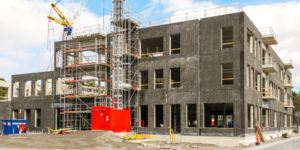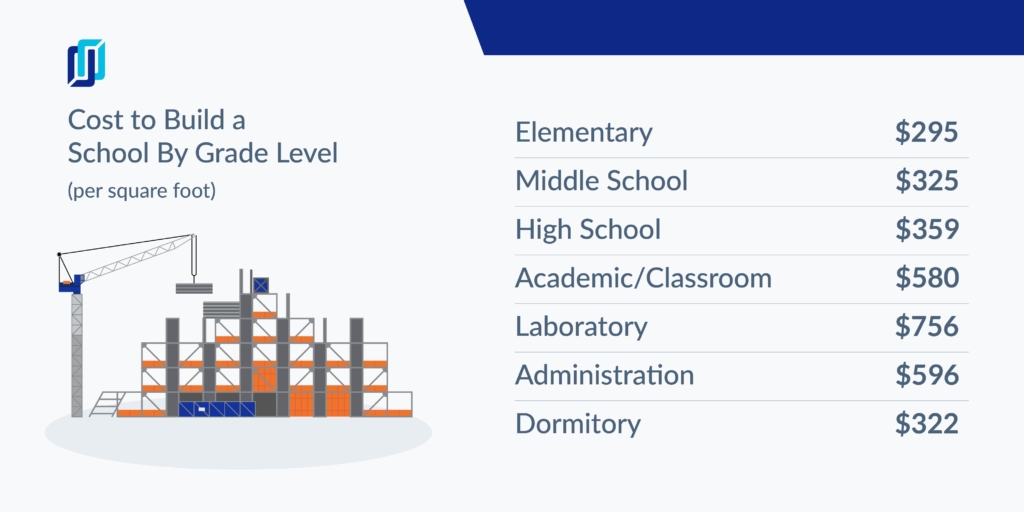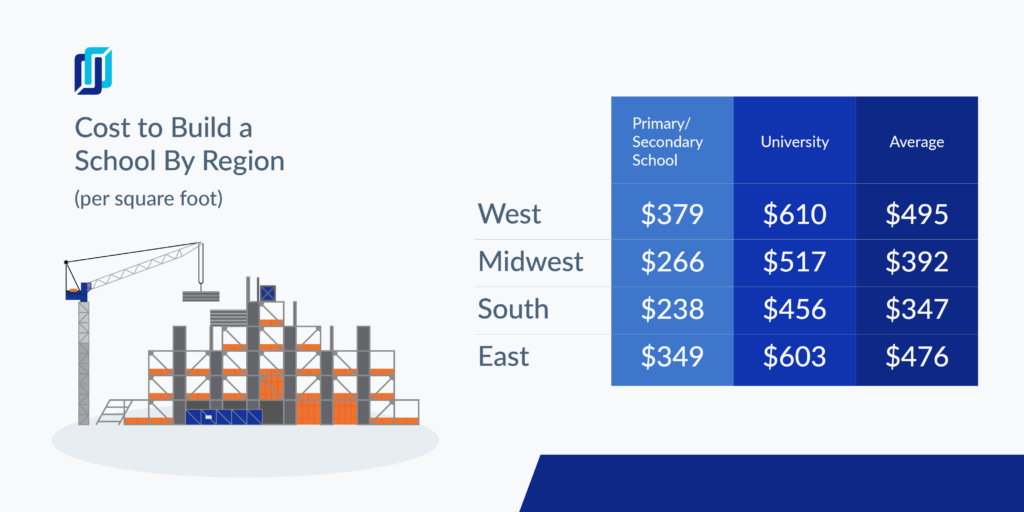
Whether you’re a builder moving into the education sector or a school administrator proposing a new building, knowing the cost to build a school is important for budgeting, estimating, and forecasting. In general, the cost to build a school ranges from $295 to $756 per square foot. The actual cost depends on a wide variety of factors, including location, materials used, the number of floors, and more. We’ll go deeper into the breakdown of those costs and the types of costs associated with education construction in this article.
Cost to build a school per square foot
The cost for constructing school buildings varies wildly based on the type of school and region. University dorm buildings aren’t terribly different from apartment buildings, and they’re on the lower end of costs. Conversely, facilities with laboratories or athletic facilities can cost much more.’


Other building costs to consider
Square foot estimates are helpful when trying to determine how much a building will cost, but they don’t tell the whole story. When dissecting the cost to build a school, you need to understand that there are different types of costs wrapped up in those per-square-foot estimates.
- Hard Costs account for the cost of the materials, labor, equipment, property, site work, utilities, and other expenses directly related to building the structure.
- Soft Costs include the money spent on taxes, legal fees, permits, designs and drawings, and other costs not directly related to the structure.
- Finance Costs include the costs to borrow the money for the building, including interest and finance charges.
- Long-term Costs include the costs to maintain the building, such as maintenance, utility costs, and other monthly expenses directly related to the building’s design. Long-term costs can be difficult to account for on a per-square-foot basis, but they’re costs worth keeping in mind.
Types of schools
When it comes to the cost to build a school, the type of facility in question has a large impact on the project. Different grades, ages, and facilities have specific requirements, and the more advanced the educational offerings, the more expensive the building will typically be.
Cost to build an elementary school
On average, building an elementary school costs $295 per square foot. Elementary school construction is generally the least expensive type of education building to construct. At these lower grade levels, the technological requirements are generally lower, and athletic spaces require less infrastructure.
Cost to build a middle school
The cost to build a middle school is $325 per square foot, on average. As children grow, their school buildings need to develop with them. Larger children need better HVAC systems. Their access to technology increases and requires more complex infrastructure. Often, these schools also have sporting facilities, and cafeteria kitchens generally require more equipment.
Cost to build a high school
Construction of a high school averages $359 per square foot nationally. This jump is due to a number of factors. High school students are physically larger than middle or elementary students, and a greater number of them need to be housed under one roof. Many municipalities may have multiple schools for lower grades that combine the student population into a single, larger high school. High schools also have increased investment in education technology, athletic facilities, and other add-ons.
Cost to build university buildings
The average cost to build at a university depends largely on the type of building. Nailing down a cost to build a university can be difficult, as the type of university and its offerings significantly affect the overall cost.
- Tech and science lab facilities: $760 per square foot
- General academic buildings: $580 per square foot
- Dorm buildings: $322 per square foot
Planning and construction
As a prospective property owner, contractor, or school district approaches building a new school, there are a lot of factors to consider. Between understanding the costs and what impacts them, as well as choosing the best materials, there’s a lot of work to do.
What impacts school construction costs
The cost to build a school is impacted in many ways. First, regional economic variances play a major role. Building of any type is typically more expensive on the East and West coasts than it is in the South or Midwest.
Demand is also a factor. School districts in areas with fewer projects will often receive competitive bids. These contractors need to fill their schedules, so they’re often willing to cut their prices. In areas ripe with projects, contractors can be selective and essentially name their prices without fear of their calendar drying up.
Also, consider that buildings built using union labor will likely cost more than those built by open shops. Between the union fees, higher wages, and better benefits, company owners need to submit higher bids to cover their costs.
Building material selection
Another major contributing factor is materials. The more expensive the materials, the higher the cost of the actual construction will be. But availability is also a problem. When materials aren’t readily available, the cost of stock jumps considerably.
Schools often rely on these materials in large quantities, such as vinyl flooring and drop ceiling tiles or expensive technology infrastructure. When these materials jump 10 or 15 percent overnight, the cost of building the school jumps as well.
Who is involved in school construction?
As it is with any construction project, there are a lot of moving parts in school construction. At the granular level, it starts with taxpayers and school district administrators. However, the actual process of planning and constructing the building also involves several parties.
The architect
Before construction can begin, an architect needs to design and draw plans for the building. They’ll come up with the overall design, the different materials and specifications, the finishes, and an initial budget. They might help the owner (in this case, the school district) select a general contractor as well. Most architecture firms can also act as the project manager, oversee the project, and administer payments.
General contractor
When it comes to getting the project off the ground, the general contractor is the party responsible. They’ll enter into a contract with the school district, handle the permits and inspections, hire all the subcontractors, and be responsible for the general direction of the school project.
From a financial perspective, the General Contractor is arguably a school district’s most important hire. They are in control of hiring all of the subcontractors who will actually complete the majority of the work. The GC is also responsible for managing payments down the chain to all of the subs and suppliers under them. Missed payments or financial mismanagement could lead to schedule delays or payment disputes that add to the school’s construction cost.
It’s critical for school administrators to prequalify the contractors they hire — not just for the quality of past work, but the contractor’s history of payments and financial disputes on past projects as well. Payment problems can quickly lead to lien claims on the property.
Subcontractors
Subcontractors or specialty contractors are the boots on the ground doing the majority of the work. In the case of a school project, subs can include masonry, steel erection, electrical, plumbing, telecommunication, painting, flooring, and more. These contractors generally enter into contracts with the general contractor.
The school district may not be aware of all of the subcontractor companies working on the construction. This lack of transparency poses a significant risk to the property owner or agency in charge of the project. Subcontractors — and anyone hired by subcontractors — can generally file a mechanics lien on the school if they don’t receive payment for their work.
Stages of building
A school construction project consists of several stages. Everyone on the job needs time to handle their part of the project.
The initiation
The first step of the project is the initiation stage. This is the point where the school district and designers explore the idea of the project. This stage exists to determine whether the project is feasible in scope, time, and budget.
Because a school has so many stakeholders, the initiation and design phase is often the longest stage of a school construction project. This is especially true for public school districts that will be paying for construction costs with a bond issue. They need public approval of the project before anyone can break ground.
Pre-construction
Things start getting exciting at the pre-construction phase. This is when the architect will design the building. The GC will also sign a contract with the project owner, submit permit paperwork, and procure many of the materials, equipment, and subcontractors.
Construction
The construction phase is where the rubber really meets the road. The GC will oversee the subs as they perform site work, pour foundations, build walls and roofs, and run utilities. And, while the GC is handling the scheduling and communicating with the designer and project owner, inspections are occurring along the way.
Post-construction
Once the majority of the project wraps up, the school will be in the post-construction phase. Subs will break down their equipment and clean up the site, the GC will assign punch lists, and final inspections occur. Once the job reaches substantial completion or receives its certificate of occupancy, final payments are due to all of the contractors and subs who worked on the project. This includes payment of retainage, which is typically withheld from the contractors during the construction phase.
How long does it take to build a school?
Building a school does take time. Most school projects are complete within two years from the start of planning, but this depends on many factors.
The site conditions, materials availability, permitting process, and complexity of the building design will all impact the timeline. Also, subcontractor demand, budget, and delays can play a role.
Schedule Delay: How to Assess & Reduce Impact in Construction
Payment Risks for Contractors
As far as construction projects go, building schools is usually one of the least risky. The construction is typically paid for by a bond issue, meaning there’s less of a chance of the money running out or the project owner skipping town (and payments).
But that doesn’t mean building a school doesn’t come without any risks. Getting paid on school projects can take painfully long, and contractors can feel the pinch in between payments.
Contractors can file mechanics liens to speed up payments on private school projects. In these cases, contractors need to protect their rights to a mechanics lien by sending preliminary notice and adhering to state-specific guidelines. On public school projects, unpaid contractors can file a claim against the payment bond.
